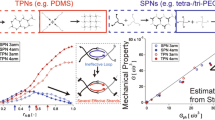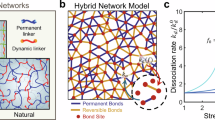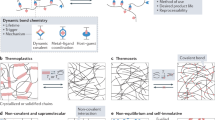Abstract
Dynamic networks constructed by physical cross-links between polymer chains can change their structure through the association and dissociation of cross-linking points. This paper yields experimental data about the transient change of the dynamic storage modulus G′ for a molten random copolymer of vinyl acetate and vinyl alcohol with a vinyl alcohol content of 60 mol%, in which physical cross-links are formed via hydrogen bonding. As the cross-link density depends on temperature, the storage modulus G′ of the system slowly evolves toward equilibrium at the experimental temperature, Ta, after changing the temperature from higher or lower than Ta. The characteristic time scale for the equilibration is on the order of 103~104 s (depending on Ta) and the time evolution curves of G′ are dependent on the thermal history. The ‘memory effect’ (the structure developed at a certain temperature is preserved after changing the temperature) found in the system is discussed in detail.
Similar content being viewed by others
Log in or create a free account to read this content
Gain free access to this article, as well as selected content from this journal and more on nature.com
or
References
Struik, L. C. E. Physical Aging in Polymers and Other Amorphous Materials, (Elsevier, Amsterdam, 1978).
Angell, C. A., Ngai, K. L., McKenna, G. B., McMillan, P. F. & Martin, S. W. Relaxation in glassforming liquids and amorphous solids. J. Appl. Phys. 88, 3113–3157 (2000).
Bellon, L., Ciliberto, S. & Laroche, C. Advanced memory effects in the aging of a polymer glass. Eur. Phys. J. B 25, 223–231 (2002).
Wang, X. R. Time-temperature independence of aging-induced relaxation peak in the glassy state. Macromol. Rapid Commun. 23, 530–534 (2002).
Fukao, K. & Sakamoto, A. Aging phenomena in poly(methyl methacrylate) thin films: memory and rejuvenation effects. Phys. Rev. E 71, 041803-1-12 (2005).
Cavaille, J. Y., Etienne, S., Perez, J., Monnerie, L. & Johari, G. P. Dynamic shear measurements of physical aging and the memory effect in a polymer glass. Polymer 27, 686–692 (1986).
Jonason, K., Vincent, E., Hammann, J., Bouchaud, J. P. & Nordblad, P. Memory and chaos effects in spin glasses. Phys. Rev. Lett. 81, 3243–3246 (1998).
Nordblad, P. Spin glasses: model systems for non-equilibrium dynamics. J. Phys. Condens. Matter 16, S715–S722 (2004).
Frauenfelder, H., Sligar, S. G. & Wolynes, P. G. The energy landscapes and motions of proteins. Science 254, 1598–1603 (1991).
Zou, L. N. Spectral responses in granular compaction. Phys. Rev. E 81, 031302-1-14 (2010).
Parker, A. & Normand, V. Glassy dynamics of gelatin gels. Soft Matter 6, 4916–4919 (2010).
Lange, R. F. M., Van Gurp, M. & Meijer, E. W. Hydrogen-bonded supramolecular polymer networks. J. Polym. Sci. Pol. Chem. 37, 3657–3670 (1999).
Feldman, K. E., Kade, M. J., Meijer, E. W., Hawker, C. J. & Kramer, E. J. Model transient networks from strongly hydrogen-bonded polymers. Macromolecules 42, 9072–9081 (2009).
Noro, A., Matsushita, Y. & Lodge, T. P. Thermoreversible supramacromolecular ion gels via hydrogen bonding. Macromolecules 41, 5839–5844 (2008).
Sakamoto, A., Ogata, D., Shikata, T., Urakawa, O. & Hanabusa, K. Large macro-dipoles generated in a supramolecular polymer of N,N',N''-tris(3,7-dimethyloctyl) benzene-1,3,5-tricarboxamide in n-decane. Polymer 47, 956–960 (2006).
Jeffry, G. A. An Introduction to Hydrogen Bonding, (Oxford University Press, New York, 1997).
Semenov, A. N. & Rubinstein, M. Thermoreversible gelation in solutions of associative polymers. 1. Statics. Macromolecules 31, 1373–1385 (1998).
Rubinstein, M. & Semenov, A. N. Thermoreversible gelation in solutions of associating polymers. 2. Linear dynamics. Macromolecules 31, 1386–1397 (1998).
Minsk, L. M., Priest, W. J. & Kenyon, W. O. The alcoholysis of polyvinyl acetate. J. Am. Chem. Soc. 63, 2715–2721 (1941).
Moritani, T. & Fujiwara, Y. C-13-NMR and H-1-NMR investigations of sequence distribution in vinyl alcohol vinyl acetate copolymers. Macromolecules 10, 532–535 (1977).
Isasi, J. R., Cesteros, L. C. & Katime, I. Hydrogen-bonding and sequence distribution in poly(vinyl acetate-co-vinyl alcohol) copolymers. Macromolecules 27, 2200–2205 (1994).
Urakawa, O., Ikuta, H., Noubukawa, S. & Shikata, T. Small-angle neutron scattering study on the miscibility and concentration fluctuation of hydrogen-bonded polymer blends. J. Polym. Sci. Pol. Phys. 46, 2556–2565 (2008).
Coleman, M. M., Graf, J. F. & Painter, P. C. Specific Interactions and the Miscibility of Polymer Blends, (Technomic, Lancaster, PA, 1991).
Ferry, J. D. Viscoelastic Properties of Polymers4th edn (Wiley, New York, 1980).
Fecko, C. J., Eaves, J. D., Loparo, J. J., Tokmakoff, A. & Geissler, P. L. Ultrafast hydrogen-bond dynamics in the infrared spectroscopy of water. Science 301, 1698–1702 (2003).
Debenedetti, P. G. & Stillinger, F. H. Supercooled liquids and the glass transition. Nature 410, 259–267 (2001).
Parisi, G. & Sciortino, F. Structural glasses flying to the bottom. Nat. Mater. 12, 94–95 (2013).
Acknowledgements
This work was supported by JSPS KAKENHI Grant Number 21350126.
Author information
Authors and Affiliations
Corresponding author
Ethics declarations
Competing interests
The authors declare no conflict of interest.
Additional information
Supplementary Information accompanies the paper on Polymer Journal website
Supplementary information
Rights and permissions
About this article
Cite this article
Urakawa, O., Shimizu, A., Fujita, M. et al. Memory effect in elastic modulus of a hydrogen-bonding polymer network. Polym J 49, 229–236 (2017). https://doi.org/10.1038/pj.2016.113
Received:
Revised:
Accepted:
Published:
Issue date:
DOI: https://doi.org/10.1038/pj.2016.113



